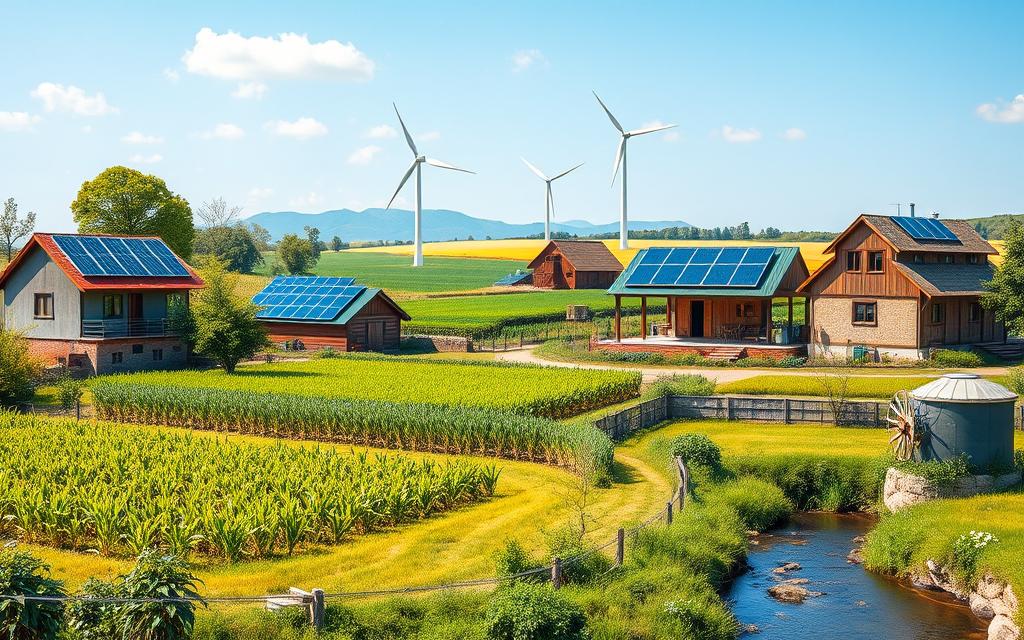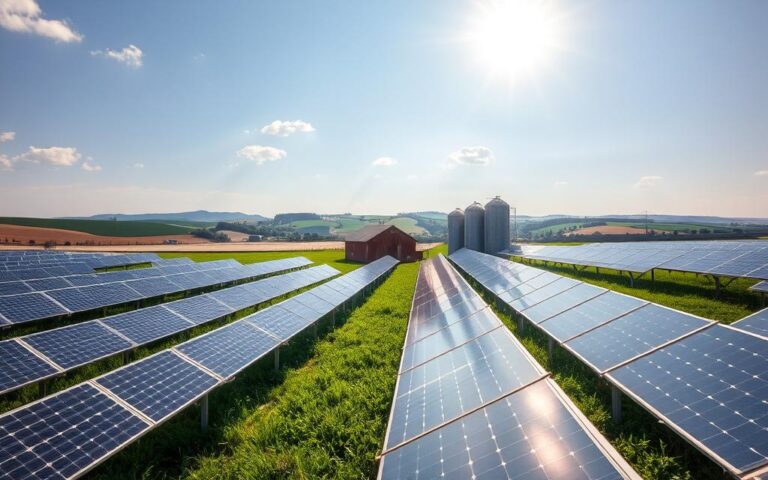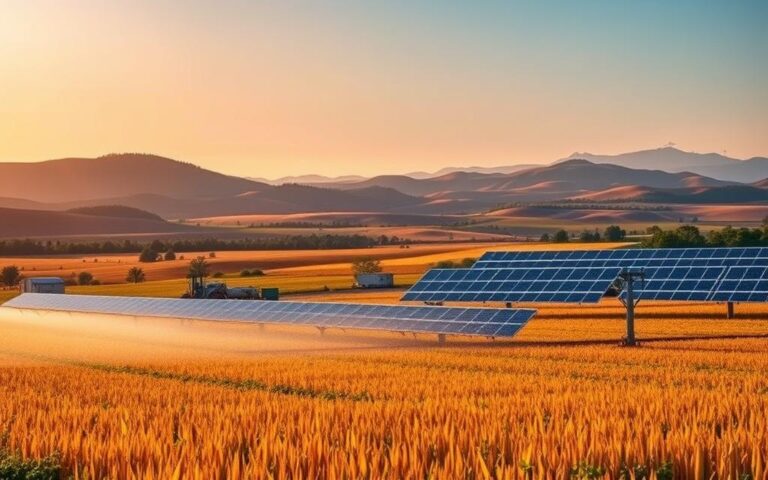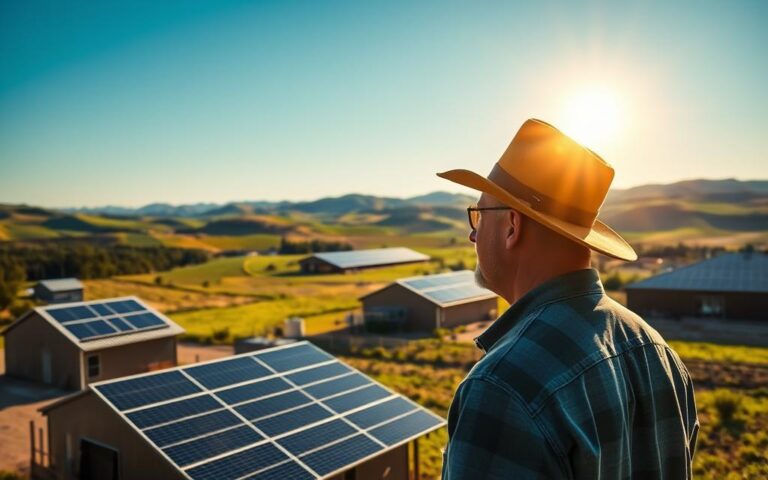Small-scale farmers in the U.S. spend up to 30% of their budget on energy costs. This makes affordable energy solutions vital for agricultural sustainability. Renewable energy technologies are changing how farmers manage energy.
Farmers face challenges in managing energy expenses while maintaining productive operations. Sustainable agriculture requires innovative approaches to reduce energy consumption. Cost-effective solutions are essential for small-scale farmers to thrive.
Renewable energy technologies offer promising ways for farmers to cut operational costs. Solar panel installations and wind energy systems are now affordable options. These solutions can significantly lower farmers’ economic burden.
These energy solutions provide financial relief and contribute to environmental conservation. By using renewable energy, farmers can create more resilient agricultural practices. This benefits both their businesses and the broader ecosystem.
Let’s explore five affordable energy solutions for small-scale farmers. These strategies can transform energy management in agricultural settings. They address the unique challenges faced by farmers today.

Understanding Affordable Energy for Farmers
U.S. farmers face major challenges in managing energy costs while maintaining sustainable practices. The clean energy shift is now an economic must for modern farms. It’s not just about helping the environment anymore.
Energy efficiency in farming offers a chance to cut costs and boost sustainability. Small farmers often struggle with rising energy bills. These costs can greatly affect their profits.
The Importance of Cost-Effective Energy Solutions
- Reduce operational expenses
- Minimize environmental impact
- Improve long-term farm sustainability
- Create opportunities for technological innovation
“Sustainable agriculture is not just about production—it’s about creating resilient farming systems that can adapt to changing economic and environmental conditions.” – Agricultural Sustainability Expert
Key Challenges Facing Farmers Today
The current agricultural landscape presents multiple energy-related challenges:
- Escalating electricity and fuel costs
- Limited access to renewable energy technologies
- High initial investment requirements
- Complex regulatory environments
Embracing energy efficiency and exploring new energy sources can help farmers overcome these hurdles. The clean energy shift offers a path to more viable and responsible farming.
This transition can lead to cost savings and greener practices. It also opens doors to new tech and methods in agriculture.
Renewable Energy Technologies Overview
Farmers in the U.S. are finding new opportunities through renewable energy tech. These innovative solutions provide sustainable and cost-effective power for agricultural operations.
Modern farms need smart energy solutions to cut costs and reduce environmental impact. Renewable energy tech helps farmers become more energy independent and economically resilient.

Types of Renewable Energy for Agriculture
Farms can use several renewable energy technologies:
- Solar power systems for consistent electricity generation
- Wind turbines for large open farmland areas
- Biomass energy from crop waste
- Geothermal heating and cooling systems
Benefits of Implementing Renewable Energy
Using renewable energy tech offers farmers many advantages:
- Reduced energy expenses
- Lower carbon footprint
- Potential additional income streams
- Enhanced farm resilience
“Renewable energy is not just an environmental choice, but a strategic business decision for modern farmers.” – Clean Energy Research Institute
Wind turbines and solar power systems are promising for farms. These solutions can generate electricity on-site, cutting traditional energy costs.
Excess power generation might even create new revenue streams. By using renewable energy, farmers can make their operations more sustainable and profitable.
Solar Energy Solutions for Small Farms
Solar power systems are revolutionizing agricultural operations for rural farmers. They offer affordable energy, reducing costs and boosting sustainability. This technology is no longer a dream but an achievable reality.
Solar tech now offers specialized solutions for farms. These cutting-edge installations work seamlessly with existing farm infrastructure. Farmers can easily adopt these systems to improve their operations.
Types of Solar Panels for Agricultural Use
- Monocrystalline panels: High efficiency for limited space
- Polycrystalline panels: Cost-effective option for larger farm areas
- Thin-film solar panels: Flexible installation on various surfaces
Cost-Reducing Solar Energy Programs
Rural electrification programs offer financial incentives for farmers adopting solar tech. These federal and state programs provide valuable support.
- Tax credits up to 30% of installation costs
- Grants for renewable energy infrastructure
- Low-interest loans for solar system investments
Integration of Solar Power into Farming Operations
Strategic solar implementation can transform farming economics. Farmers can mount panels on barns or place them in unused fields. They can also integrate solar tech into irrigation systems.
“Solar energy represents not just a technology, but a comprehensive solution for modern agricultural sustainability.” – Clean Energy Research Institute
Solar power systems offer multiple benefits to farmers. They can reduce energy costs and increase property value. Additionally, these systems contribute significantly to environmental conservation.
Wind Energy as an Alternative Source
Wind turbines are changing farm power solutions. Farmers can now use wind power as a sustainable energy option. Both small and large farms can benefit from this clean energy source.
Wind energy offers farmers many benefits over traditional power sources. It allows farmers to generate electricity while still growing crops. This makes wind turbines a smart choice for modern farms.
Harnessing Wind Power on Farms
Farmers can use wind energy in several ways:
- Small-scale turbines for individual farm operations
- Community wind energy projects
- Collaborative installations with neighboring farms
- Leasing land for larger commercial wind farms
Assessing Wind Turbine Costs and Benefits
Understanding the costs of wind turbines is important for farmers. Here’s a comparison of key factors to consider:
| Aspect | Small Turbine | Large Turbine |
|---|---|---|
| Initial Investment | $15,000 – $75,000 | $300,000 – $1,000,000 |
| Annual Energy Production | 10,000 – 50,000 kWh | 500,000 – 2,000,000 kWh |
| Payback Period | 5-10 years | 3-7 years |
“Wind energy represents not just an alternative power source, but a strategic agricultural investment.” – Clean Energy Research Institute
Clean energy offers farmers great opportunities. It can cut costs and create new income. Plus, it helps make farming more eco-friendly.
Biomass and Bioenergy Options
Sustainable agriculture is changing how farmers produce energy. Biofuel production turns agricultural waste into valuable energy resources. This renewable energy technology is revolutionizing farming practices.
Farmers are finding new ways to turn organic materials into renewable energy. The potential for sustainable energy on farms is vast. This innovation opens up exciting possibilities for agricultural communities.
Types of Biomass Suitable for Farming
- Crop residues (corn stalks, wheat straw)
- Animal manure
- Agricultural waste products
- Dedicated energy crops
These biomass sources offer unique opportunities for farmers. They can create on-site renewable energy technologies while reducing waste. Additionally, this process can generate extra income for farm operations.
Converting Waste into Energy
The process of converting agricultural waste into energy involves several key steps:
- Collection of organic waste materials
- Processing and breaking down biomass
- Generating biogas or biofuel
- Utilizing energy for farm operations
“Turning waste into energy is not just an environmental solution, but an economic opportunity for modern farmers.” – Sustainable Agriculture Research Institute
Biofuel production strategies offer multiple benefits to farmers. They can cut energy costs and minimize waste. These practices also contribute to the growth of renewable energy technologies.
The link between agricultural production and energy generation is promising. It represents a new frontier in sustainable farming. This approach benefits both farmers and the environment.
Energy Efficiency Practices in Agriculture
Smart energy management is key in sustainable farming. U.S. farmers are finding new ways to cut energy use while staying productive. This boosts farm profits and helps the environment.
Energy efficiency is vital for farm success. It helps reduce costs and protects our planet. Farmers can use many strategies to save energy.
To lower energy costs, farmers need a full plan. This plan should cover all parts of farm work. Here are some ways farmers can use less energy:
- Upgrade to energy-efficient irrigation systems
- Implement precision agriculture technologies
- Optimize equipment maintenance schedules
- Utilize natural lighting and ventilation
Strategies to Reduce Energy Consumption
Today’s farmers use high-tech tools to track energy use. Affordable energy for farmers starts with knowing how much they use. They can then find ways to improve.
| Energy Efficiency Strategy | Potential Savings | Implementation Difficulty |
|---|---|---|
| LED Lighting in Barns | 30-50% Reduction | Low |
| Variable Speed Drive Motors | 20-40% Reduction | Medium |
| Solar-Powered Equipment | 50-70% Reduction | High |
Tools for Monitoring Energy Usage
Smart tech helps farmers watch energy use in real-time. Digital tools and sensors show how much power farm tasks need. This info helps farmers make smart choices.
“Energy efficiency is not just about cutting costs, but about creating a sustainable agricultural future.” – Agricultural Energy Experts Network
Energy-smart farming cuts costs and helps the planet. Smart planning and new tech offer great ways to farm better. This approach saves money and protects our environment.
Government Incentives and Support Programs
Farmers can access multiple government support mechanisms for renewable energy technologies. These programs speed up rural electrification and offer financial help for sustainable farming practices.
Federal Grants for Renewable Energy
The USDA offers targeted grant programs to help farmers switch to clean energy solutions. These incentives aim to lower initial investment barriers for sustainable farming practices.
- Rural Energy for America Program (REAP) grants
- Environmental Quality Incentives Program (EQIP)
- Agricultural Conservation Easement Program
State-Specific Initiatives for Farmers
States provide unique renewable energy support tailored to local agricultural needs. These initiatives can greatly reduce implementation costs for farmers.
| State | Renewable Energy Initiative | Maximum Grant Amount |
|---|---|---|
| California | Solar Agricultural Pump Program | $150,000 |
| Iowa | Renewable Energy Farm Credit | $75,000 |
| New York | Farm Renewable Energy Grant | $100,000 |
“Investing in renewable energy is not just an environmental choice, but a strategic economic decision for modern farmers.” – USDA Renewable Energy Specialist
Farmers should reach out to local agricultural extension offices for more information. State energy departments can also provide details about specific programs in their region.
Community-Based Renewable Energy Projects
Rural communities are changing how they get energy. They’re using new team approaches with renewable energy tech. This shift lets local farmers join clean energy projects.
Community-driven renewable energy projects are changing small-scale farming. These joint efforts let people share resources and costs. They create lasting energy solutions that benefit everyone.
Collaborative Solar Farms: Shared Power Solutions
Collaborative solar farms are a new way to make community energy. Farmers can team up to share costs and split energy output. This approach helps them use land better and earn money together.
- Share installation costs
- Distribute energy infrastructure
- Maximize land use efficiency
- Generate collective income streams
Local Wind Energy Initiatives
Wind energy projects give rural areas control over their power. Farmers can use wind resources through smart partnerships. These local efforts create new opportunities for clean energy.
| Project Type | Investment Range | Annual Energy Output |
|---|---|---|
| Small Community Wind Farm | $50,000 – $200,000 | 100-500 MWh |
| Cooperative Wind Project | $250,000 – $750,000 | 500-1500 MWh |
“Community-based renewable energy projects are not just about generating power—they’re about generating opportunity.” – Clean Energy Research Institute
These team efforts help rural areas build strong, lasting energy systems. They boost local economies and protect the environment. By working together, communities create a brighter future for everyone.
Case Studies of Successful Implementations
Renewable energy is changing sustainable farming in the US. Farmers are finding new ways to use affordable energy. These solutions cut costs and help the environment.
Real-world examples show how energy investments boost sustainable farming. Farmers are successfully using renewable energy in their work. These case studies highlight their achievements.
Innovations in Renewable Energy Among Farmers
- Solar-powered irrigation systems reducing electricity expenses
- Wind turbine installations generating additional farm income
- Biomass conversion turning agricultural waste into energy
The Midwest offers great examples of affordable energy for farmers. Small farms use renewable tech to become stronger. These practices also make farming more profitable.
Economic Benefits Realized from Energy Solutions
| Farm Type | Energy Solution | Annual Savings |
|---|---|---|
| Dairy Farm (Wisconsin) | Biogas Digester | $45,000 |
| Crop Farm (Kansas) | Solar Panel Installation | $35,000 |
| Mixed Agriculture (Iowa) | Wind Turbine | $55,000 |
“Renewable energy isn’t just environmentally smart—it’s economically intelligent for modern farmers.” – Agricultural Sustainability Research Institute
These studies show that renewable energy offers real economic benefits. Farmers using sustainable energy can greatly reduce their costs. They also help protect the environment.
Future Trends in Affordable Energy for Farmers
Farmers are leading the clean energy transition with innovative renewable technologies. These solutions offer sustainable power generation opportunities. They can slash operational costs and reduce environmental impact.
Emerging Renewable Technologies
Advanced solar panels and micro wind turbines are becoming more efficient for small farms. They’re also getting more affordable. Electric vehicle battery systems now let farmers store excess renewable energy.
This enables more resilient and independent power management. Farmers can now better control their energy use and production.
The Role of Policy in Supporting Farmers
Government incentives are speeding up clean energy adoption in farming. The U.S. Department of Agriculture offers financial support, tax credits, and grants. These help farmers invest in renewable energy without high upfront costs.
Technology advances and policy support are expanding renewable energy options for farmers. These options balance economic feasibility with environmental sustainability. The future of farm energy is decentralized, smart, and green.
FAQ
What are the most affordable renewable energy options for small-scale farmers?
Small-scale farmers have several affordable renewable energy options. Solar power systems, wind turbines, and biomass energy solutions top the list. Solar panels are cost-effective, with government incentives making them more accessible.
Wind turbines benefit farms with consistent wind patterns. Biomass energy allows farmers to convert agricultural waste into usable energy.
How much does it cost to implement renewable energy on a small farm?
A comprehensive renewable energy system for a small farm costs between $10,000 to $50,000. Government grants, tax credits, and long-term energy savings can offset these expenses. Many farmers recover their investment within 5-10 years through reduced costs.
Are there government incentives available for farmers adopting renewable energy?
Yes, farmers can access many government incentives for renewable energy adoption. The USDA Rural Energy for America Program offers grants and loan guarantees. Federal tax credits can cover up to 30% of installation costs.
Many states provide additional local incentives for clean energy adoption.
Can renewable energy completely replace traditional energy sources on a farm?
Complete replacement is challenging, but farms can offset 70-90% of their energy needs. This is achieved through a mix of solar, wind, and biomass energy technologies. A comprehensive energy strategy and efficiency practices are key to reducing overall consumption.
What are the environmental benefits of renewable energy for agriculture?
Renewable energy in agriculture reduces carbon emissions and reliance on fossil fuels. It creates a more sustainable farming ecosystem. Farmers can combat climate change by converting waste to energy and improving soil health.
How do solar panels perform in different agricultural environments?
Solar panels are effective in various agricultural settings. Ground-mounted systems work well in open fields. Roof-mounted panels can be installed on farm buildings. Solar panel canopies over crops provide shade while generating electricity.
What maintenance is required for farm renewable energy systems?
Renewable energy systems need minimal maintenance. Solar panels require annual cleaning and occasional inspection. Wind turbines need periodic lubrication and blade checks. Biomass systems require regular fuel source management.
Most systems come with 20-25 year warranties. They’re designed to withstand harsh agricultural environments.
How can small farms start transitioning to renewable energy with limited budgets?
Small farms can start by: – Conducting an energy audit to identify consumption patterns – Implementing energy efficiency measures – Starting with small-scale solar installations – Exploring community renewable energy projects – Applying for government grants and low-interest loans – Gradually expanding renewable energy infrastructure as budget allows




